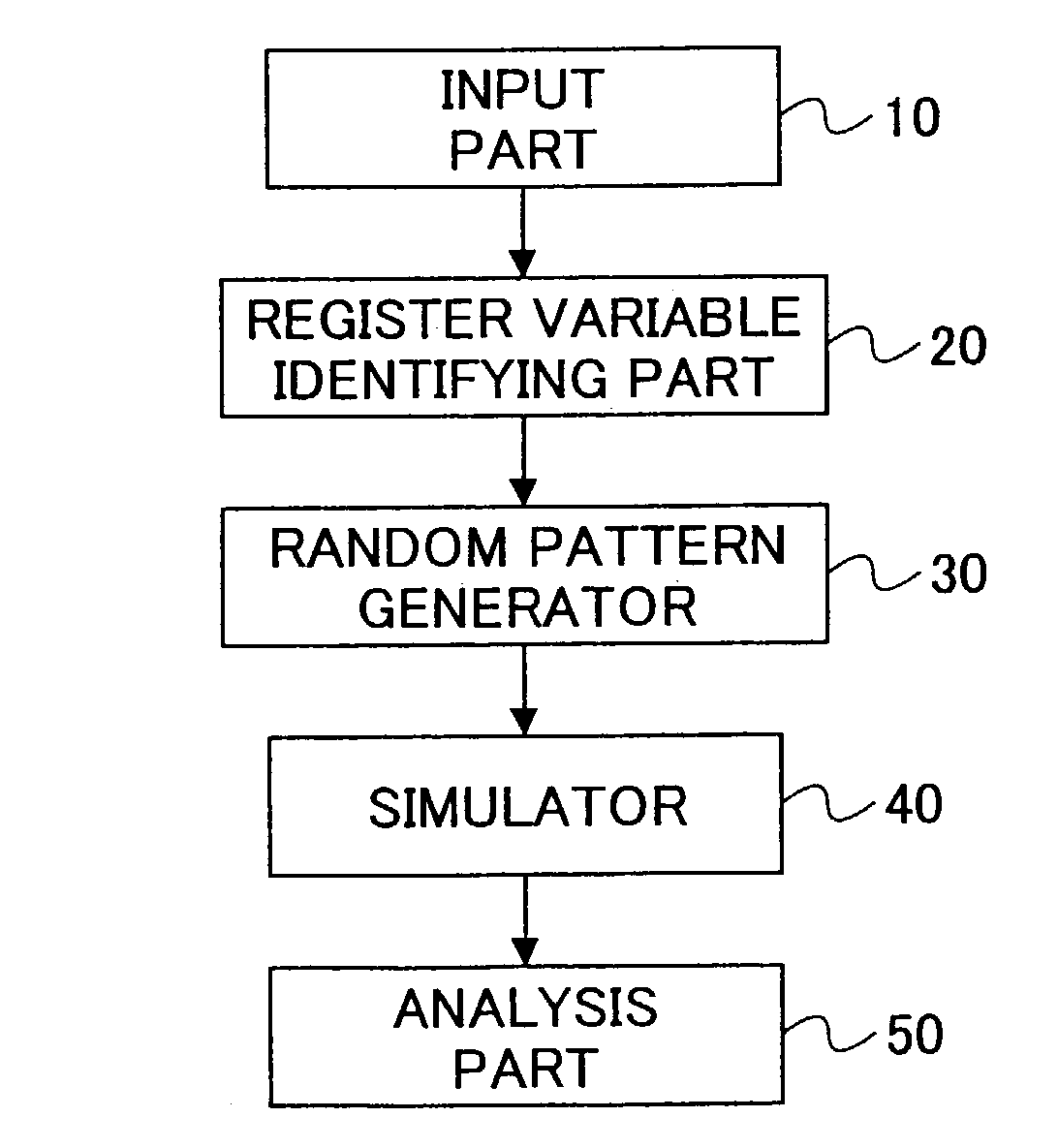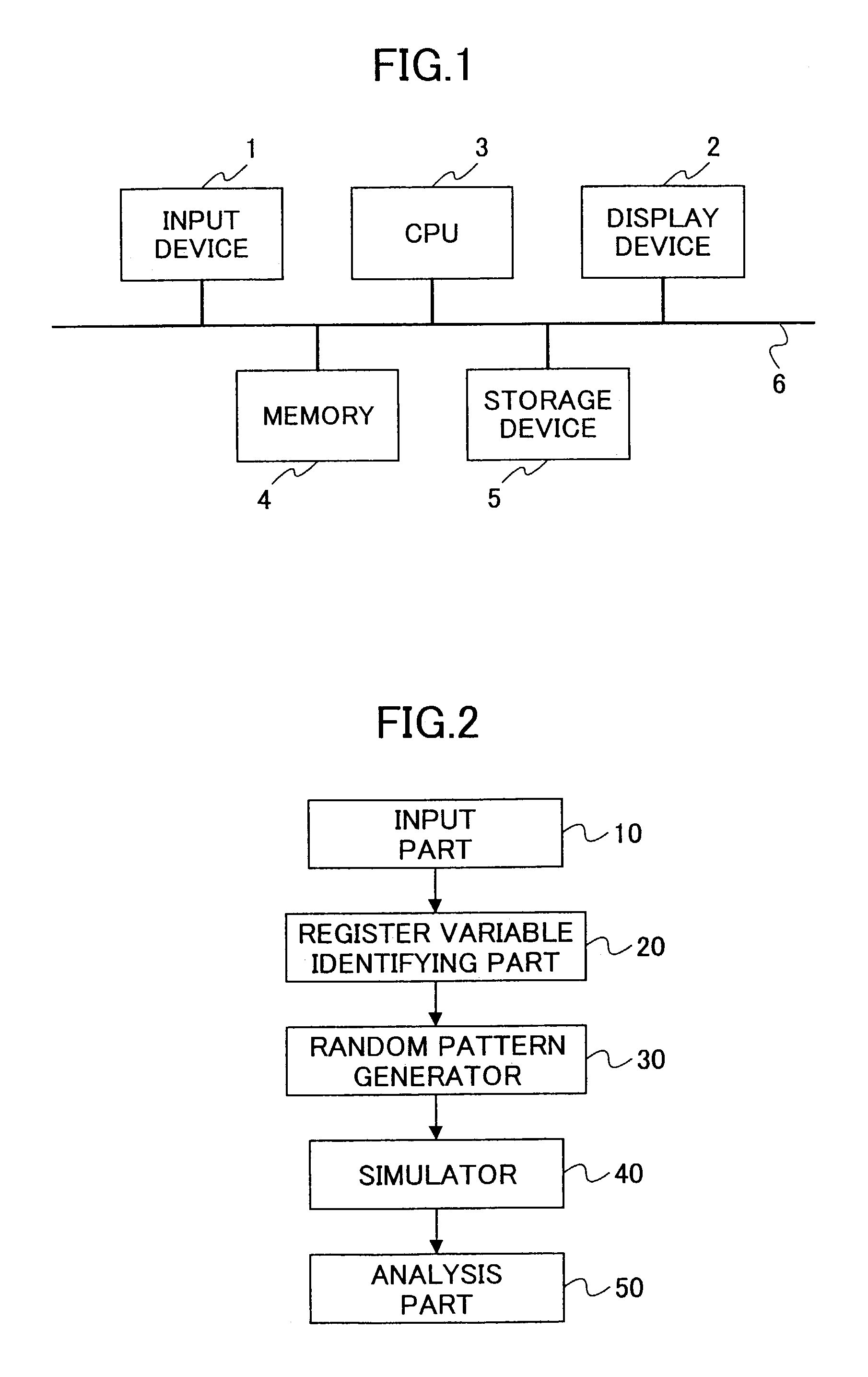System and method for improving testability independent of architecture
a testability and architecture technology, applied in the field of testability analysis systems and methods, design of testability systems and methods, can solve the problems of more large-scale, more time is required to design a test pattern for testing the integrated circuit, and the required test design time exceeds the time to design the integrated circui
- Summary
- Abstract
- Description
- Claims
- Application Information
AI Technical Summary
Benefits of technology
Problems solved by technology
Method used
Image
Examples
first embodiment
[0043]FIG. 2 is a block diagram illustrating a functional structure of a testability analysis system according to the present invention.
[0044]In FIG. 2, a function of the first embodiment comprises an input part 10, a register variable identifying part 20, a random pattern generator 30, a simulator 40, and an analysis part 50.
[0045]The input part 10 reads a hardware functional description independent of architecture from the input device 1 and temporarily saves the read hardware functional description in the storage device 5 for a later process. Here, the hardware functional description independent of architecture is written in an IEEE standard description language such as VHDL (Very high speed IC Hardware Description Language), HDL (Hardware Description Language), and Verilog-HDL. It is noted that the input part 10 may be provided to extract a hardware functional description saved in the storage device 5 in advance.
[0046]The register variable identifying part 20 identifies register...
second embodiment
[0067]A testability analysis system and a design for testability system according to the present invention are provided to give constraints for a LogicBIST execution before random patterns are applied and forced. For example, when a test is conducted by a scan path, it is necessary to turn off an asynchronous reset signal so that the scan operation cannot be collapsed.
[0068]If such constraints can be appropriately set before the random patterns are applied and forced, it is possible to realize a simulation for a hardware functional description independent of architecture wherein the random patterns are applied and forced in a similar state in which LogicBIST is operated in a netlist being at the gate level.
[0069]It is noted that the LogicBIST is used together with a boundary scan testing mechanism proposed by an organization JTAG (Joint Test Action Group) whose members are semiconductor manufacturers in Europe and the U.S. In this case, it is sufficient to provide a sequence to be s...
third embodiment
[0085]As a result, in the third embodiment, it is possible to examine the testability regarding a LogicBIST testing mode when the logic synthesis is operated and to add an alternate path and a testing circuit to a net whose toggle rates and simulation events are not sufficient. Thus, it is possible to avoid a circuit timing loss caused by an addition of a testing circuit to a netlist being at the gate level as in a conventional method.
[0086]The present invention is not limited to the above-mentioned embodiments. Programs to execute individual features of the above-mentioned embodiments may be written into a recording medium such as a CD-ROM so that a CPU in a computer can read and execute the saved programs in the recording medium by saving the programs into a memory or a storage device by means of an equipped medium driving device such as a CD-ROM drive. Also in the above method, the present invention is achieved.
[0087]Also, if the above-programs are saved in a ROM (Read Only Memor...
PUM
 Login to View More
Login to View More Abstract
Description
Claims
Application Information
 Login to View More
Login to View More - R&D
- Intellectual Property
- Life Sciences
- Materials
- Tech Scout
- Unparalleled Data Quality
- Higher Quality Content
- 60% Fewer Hallucinations
Browse by: Latest US Patents, China's latest patents, Technical Efficacy Thesaurus, Application Domain, Technology Topic, Popular Technical Reports.
© 2025 PatSnap. All rights reserved.Legal|Privacy policy|Modern Slavery Act Transparency Statement|Sitemap|About US| Contact US: help@patsnap.com



